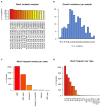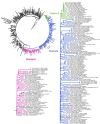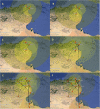The Delta variant wave in Tunisia: Genetic diversity, spatio-temporal distribution and evidence of the spread of a divergent AY.122 sub-lineage
- PMID: 36684874
- PMCID: PMC9846204
- DOI: 10.3389/fpubh.2022.990832
The Delta variant wave in Tunisia: Genetic diversity, spatio-temporal distribution and evidence of the spread of a divergent AY.122 sub-lineage
Abstract
Introduction: The Delta variant posed an increased risk to global public health and rapidly replaced the pre-existent variants worldwide. In this study, the genetic diversity and the spatio-temporal dynamics of 662 SARS-CoV2 genomes obtained during the Delta wave across Tunisia were investigated.
Methods: Viral whole genome and partial S-segment sequencing was performed using Illumina and Sanger platforms, respectively and lineage assignemnt was assessed using Pangolin version 1.2.4 and scorpio version 3.4.X. Phylogenetic and phylogeographic analyses were achieved using IQ-Tree and Beast programs.
Results: The age distribution of the infected cases showed a large peak between 25 to 50 years. Twelve Delta sub-lineages were detected nation-wide with AY.122 being the predominant variant representing 94.6% of sequences. AY.122 sequences were highly related and shared the amino-acid change ORF1a:A498V, the synonymous mutations 2746T>C, 3037C>T, 8986C>T, 11332A>G in ORF1a and 23683C>T in the S gene with respect to the Wuhan reference genome (NC_045512.2). Spatio-temporal analysis indicates that the larger cities of Nabeul, Tunis and Kairouan constituted epicenters for the AY.122 sub-lineage and subsequent dispersion to the rest of the country.
Discussion: This study adds more knowledge about the Delta variant and sub-variants distribution worldwide by documenting genomic and epidemiological data from Tunisia, a North African region. Such results may be helpful to the understanding of future COVID-19 waves and variants.
Keywords: AY.122; Delta variant; SARS-CoV2; next-generation sequencing; phylogeny; spatio-temporal dynamic.
Copyright © 2023 Haddad-Boubaker, Arbi, Souiai, Chouikha, Fares, Edington, Sims, Camma, Lorusso, Diagne, Diallo, Boubaker, Ferjani, Mastouri, Mhalla, Karray, Gargouri, Bahri, Trabelsi, Kallala, Hannachi, Chaabouni, Smaoui, Meftah, Bouhalila, Foughali, Zribi, Lamari, Touzi, Safer, Alaya, Kahla, Gdoura and Triki.
Conflict of interest statement
The authors declare that the research was conducted in the absence of any commercial or financial relationships that could be construed as a potential conflict of interest.
Figures








Similar articles
-
Early introduction, dispersal and evolution of Delta SARS-CoV-2 in Southern Brazil, late predominance of AY.99.2 and AY.101 related lineages.Virus Res. 2022 Apr 2;311:198702. doi: 10.1016/j.virusres.2022.198702. Epub 2022 Jan 29. Virus Res. 2022. PMID: 35104582 Free PMC article.
-
Molecular Epidemiology of SARS-CoV-2 in Tunisia (North Africa) through Several Successive Waves of COVID-19.Viruses. 2022 Mar 17;14(3):624. doi: 10.3390/v14030624. Viruses. 2022. PMID: 35337031 Free PMC article.
-
Detection and Molecular Characterization of the SARS-CoV-2 Delta Variant and the Specific Immune Response in Companion Animals in Switzerland.Viruses. 2023 Jan 15;15(1):245. doi: 10.3390/v15010245. Viruses. 2023. PMID: 36680285 Free PMC article.
-
Whole-genome sequencing of SARS-CoV-2 reveals diverse mutations in circulating Alpha and Delta variants during the first, second, and third waves of COVID-19 in South Kivu, east of the Democratic Republic of the Congo.Int J Infect Dis. 2022 Sep;122:136-143. doi: 10.1016/j.ijid.2022.05.041. Epub 2022 May 20. Int J Infect Dis. 2022. PMID: 35598737 Free PMC article.
-
Molecular evolution of SARS-CoV-2 from December 2019 to August 2022.J Med Virol. 2023 Jan;95(1):e28366. doi: 10.1002/jmv.28366. J Med Virol. 2023. PMID: 36458547 Free PMC article. Review.
Cited by
-
Genomic surveillance of SARS-CoV-2 in North Africa: 4 years of GISAID data sharing.IJID Reg. 2024 Mar 19;11:100356. doi: 10.1016/j.ijregi.2024.100356. eCollection 2024 Jun. IJID Reg. 2024. PMID: 38655560 Free PMC article.
-
SARS-CoV-2 excretion kinetics in nasopharyngeal and stool samples from the pediatric population.Front Med (Lausanne). 2023 Oct 30;10:1226207. doi: 10.3389/fmed.2023.1226207. eCollection 2023. Front Med (Lausanne). 2023. PMID: 38020093 Free PMC article.
-
Dynamic of SARS-CoV-2 variants circulation in Tunisian pediatric population, during successive waves, from March 2020 to September 2022.Virus Res. 2024 Jun;344:199353. doi: 10.1016/j.virusres.2024.199353. Epub 2024 Mar 20. Virus Res. 2024. PMID: 38490581 Free PMC article.
-
Virological Aspects of COVID-19 in Patients with Hematological Malignancies: Duration of Viral Shedding and Genetic Analysis.Viruses. 2024 Dec 31;17(1):46. doi: 10.3390/v17010046. Viruses. 2024. PMID: 39861838 Free PMC article.
-
SARS-CoV-2 excretion and genetic evolution in nasopharyngeal and stool samples from primary immunodeficiency and immunocompetent pediatric patients.Virol J. 2025 Jan 13;22(1):9. doi: 10.1186/s12985-025-02628-7. Virol J. 2025. PMID: 39806466 Free PMC article.
References
-
- World Health Organization. Tracking SARS-CoV2 variants. (2022). Available online at: https://www.who.int/activities/tracking-SARS-CoV-2-variants (accessed February 28, 2022).
Publication types
MeSH terms
Substances
Supplementary concepts
LinkOut - more resources
Full Text Sources
Medical
Miscellaneous

